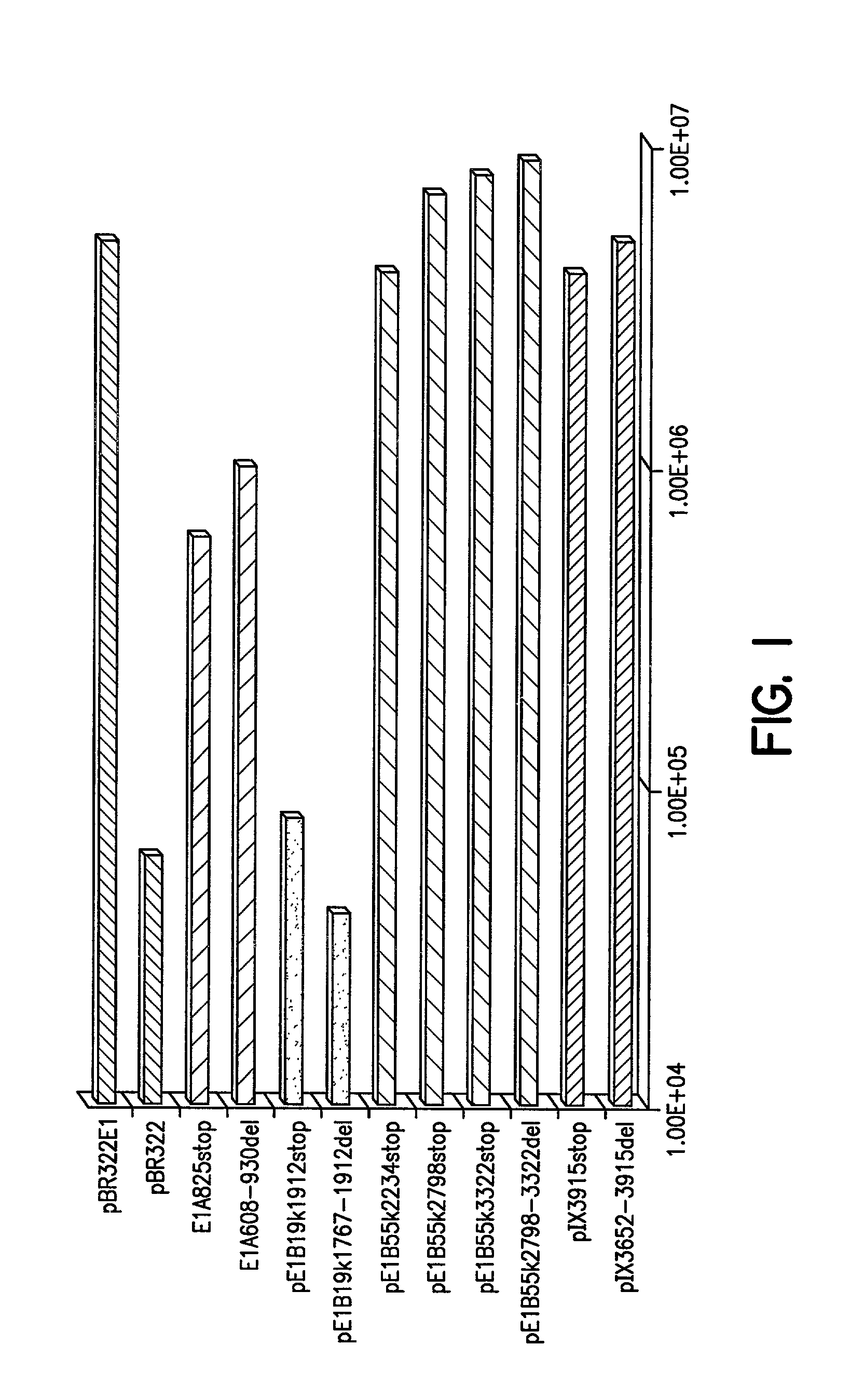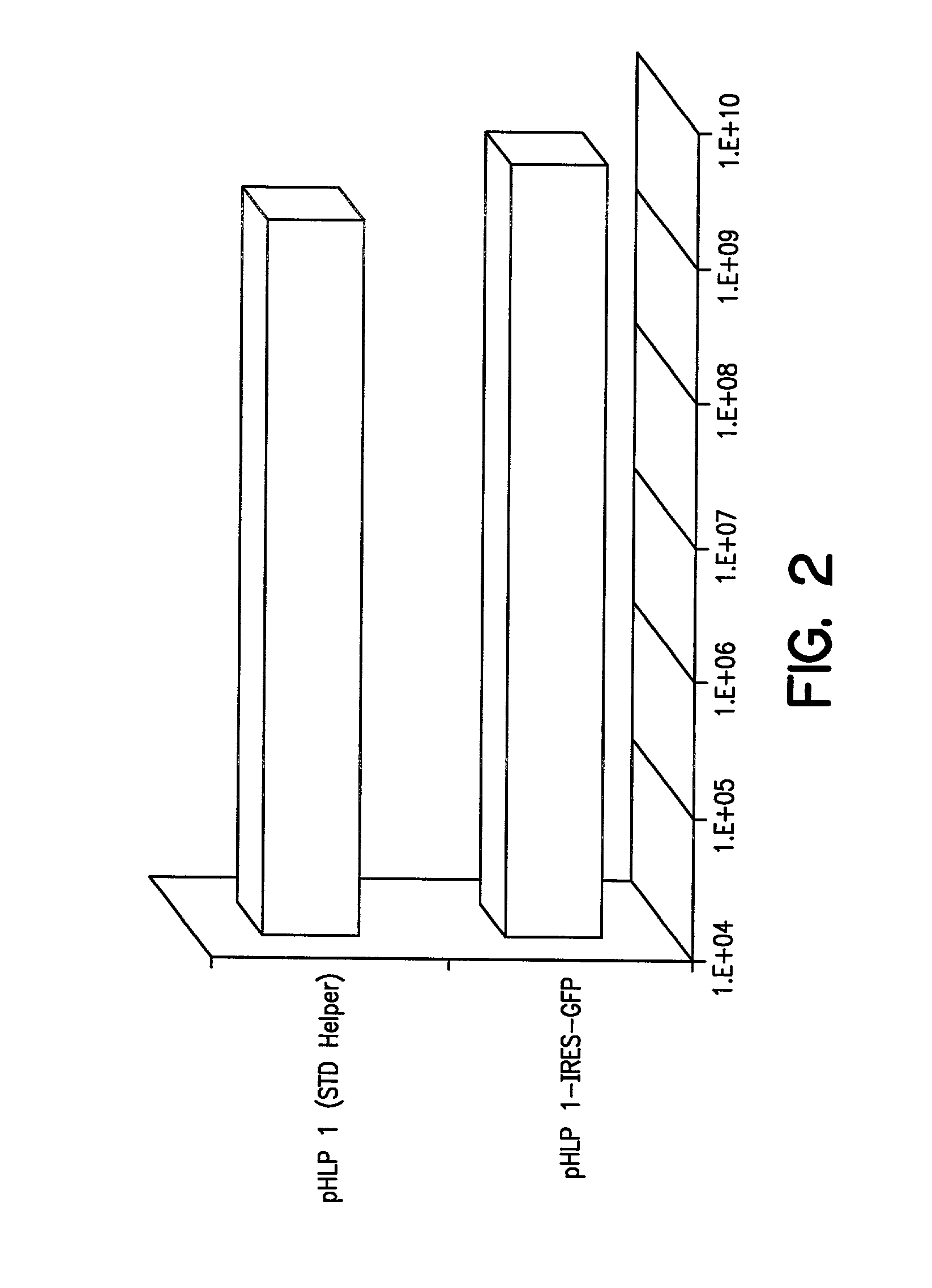Polynucleotides for use in recombinant adeno-associated virus virion production
a technology of adenovirus and adenovirus, which is applied in the direction of peptides, dsdna viruses, peptide sources, etc., can solve the problems of undesirable production of raav virions using infectious helpers such as adenovirus type-2 or herpesvirus to supply accessory functions, and significant levels of infectious adenovirus virions obtained
- Summary
- Abstract
- Description
- Claims
- Application Information
AI Technical Summary
Benefits of technology
Problems solved by technology
Method used
Image
Examples
example 1
Dissection of the Adenovirus E1 Region
Plasmid Construction
[0098] pBR322E1: Plasmid pBR322 E1 was constructed as follows. A 5785 bp AflIII E1-encoding fragment, corresponding to positions 142-5927 of adenovirus-2 was subcloned into the AflIII site of pBR322. Gene-specific truncations and deletions were made in the four reading E1 open reading frames encoded by this fragment. The numbers used to describe the positions of the mutations correspond to the locations of these sites in the adenovirus-2 sequence.
[0099] E1A alterations: Truncations and deletion mutants of the E1A region were constructed as follows. For the plasmid pE1A825stop, synthetic DNA encoding stop codons in all six frames were inserted into the BspEI site at position 825 of adenovirus-2. The sequences of the two oligos were CCGGACTAATTAACTAGT (SEQ ID NO: 1) and CCGGACTAGTTAATTAGT (SEQ ID NO:2). For plasmid pE1A608-930del, the sequence between the BstXI sites at positions 608 and 930 of pBR322E1A was removed.
[0100] E1B1...
example 2
Controlled Expression of Adenovirus Gene Products
[0111] In order to modulate transcription of genes encoding cytotoxic or cytostatic Adenovirus proteins, the following experiments were conducted.
Plasmid Construction:
[0112] Plasmids p1113A and p1113B: Plasmids p1113A and B, which contain the VA RNAs, E2A, E4, rep / cap IRES GFP, PGKNeo, and the E1region with an ecdysone-inducible E1A gene, were constructed as follows: pBluescript II SK+(Stratagene, La Jolla, Calif.) was cut with ClaI and EcoRV and ligated to synthetic DNA composed of the following oligonucleotides: CGA TAG ATC TGT TAA CTT AAT TAAGAT ATC GTT T (SEQ ID NO:19) and AAA CGA TAT CTT AAT TAA GTT AAC AGA TCT AT (SEQ ID NO:20). This plasmid was digested with BglII and HpaI and ligated to the 491 bp, Bg1II fragment from pIND (Invitrogen, Carlsbad, Calif.) encoding the ecdysone promoter. The resulting plasmid was called pBSIND. This plasmid was cleaved with PmeI and a 3946 bp SspI-Eco47III fragment encoding the entire E1 region w...
example 3
Rep-Expressing Cell Line
[0123] AAV vectors could be efficiently produced by a cell line stably containing the rep coding region if such a cell line was paired with a helper virus that carried the AAV cap coding region in addition to a complete set of accessory function genes. See FIG. 5. AAV vector sequences would also be necessary and could be located in the rep-containing cell line (integrated or episomal), in the helper virus, or could be introduced into the cell by infection. An example of this might be a cell line stably transfected with AAV rep and AAV vector sequences paired with an adenovirus containing the AAV cap gene replacing the adenovirus E3 region. Appropriate promoters for the AAV cap coding region might be the adenovirus major late promoter or an inducible promoter such as that induced by the ecdysone receptor (in this case, genes expressing the appropriate receptor subunits would also have to be resident in the producer cell or the helper virus). The advantage of u...
PUM
| Property | Measurement | Unit |
|---|---|---|
| concentration | aaaaa | aaaaa |
| nucleic acid | aaaaa | aaaaa |
| nucleic acid sequence | aaaaa | aaaaa |
Abstract
Description
Claims
Application Information
 Login to View More
Login to View More - R&D
- Intellectual Property
- Life Sciences
- Materials
- Tech Scout
- Unparalleled Data Quality
- Higher Quality Content
- 60% Fewer Hallucinations
Browse by: Latest US Patents, China's latest patents, Technical Efficacy Thesaurus, Application Domain, Technology Topic, Popular Technical Reports.
© 2025 PatSnap. All rights reserved.Legal|Privacy policy|Modern Slavery Act Transparency Statement|Sitemap|About US| Contact US: help@patsnap.com



